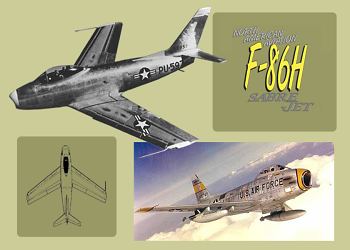
 |
North American Aviation initiated development of a purely fighter-bomber version of the Sabre on 16 March 1951 as the model NA-187.
More than 450 F-86H airframes were produced from late 1953 to August 1955. Although never used in combat, the F-86H provided the USAF with a formidable fighter-bomber aircraft until the advent of the supersonic F-100.
With a more powerful engine than its predecessors, the new design could carry a heavier payload. In order to accommodate the additional power of the General Electric J73 engine, the area of the air intake had to be increased. The fuselage was also lengthened by over two feet and widened by a few inches. Designers used the additional space inside the fuselage to increase the internal fuel capacity from 435 to 562 gallons, and four underwing stations were added for bombs or drop tanks. The horizontal and vertical tail surfaces were increased in size for greater lateral and longitudinal stability.
Several features were borrowed from the F-86D model. As in the F-86D, the horizontal tail lacked dihedral and a clamshell cockpit canopy was fitted in place of the rearward-sliding canopy of the F-86F. The cockpit was more spacious than that of any previous Sabre variant, and had a new ejection seat originally developed for the F-86D.
The Air Force initially ordered 150 of these fighter-bombers under the designation F-86H, the first two to be built in California and the remainder in Columbus, Ohio. A contract finalized on November 3, 1952 increased this order to 175.
The first F-86Hs were to have six 0.50-inch machine guns with the type A-4 GBR gunsight using the AN/APG_30 radar rangefinder, but later production aircraft were to be armed with four 20-mm T-160 cannon. Since the F-86H was to have a nuclear capability, an M-1 LABS toss-bombing computer was to be installed.
The first YF-86H-1-NA made its maiden flight on 30 April 1953, piloted by Joseph Lynch. The first of 112 Columbus-built F-86H-1-NH fighter-bombers made its maiden flight on 4 September 1953. It had extended leading edges and carried an armament of six 0.50-inch machine guns. Deliveries did not get underway in quantity until Columbus had delivered the last of its F-86F-25-NHs, which was in May of 1954.
Ten F-86Hs had been delivered by the end of June 1954, but operational testing was delayed by accidents. Responsibility for testing the airplane was assigned to the Air Force Flight Test Center at Edwards Air Force Base.
Since the airframe of the F-86H limited it to subsonic speed in level flight no matter how great the power, the production run of the F-86H was relatively short. A total of 473 were built, all but the first two at North American's Columbus, Ohio factory.
